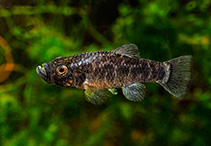| Family: |
Cyprinodontidae (Pupfishes), subfamily: Cyprinodontinae |
| Max. size: |
3.07 cm SL (male/unsexed) |
| Environment: |
benthopelagic; freshwater |
| Distribution: |
Central America: restricted to six hypersaline lakes on San Salvador Island, Bahamas: Crescent Pond, Osprey Lake, Oyster Lake, Little Lake, Mermaid Pond and Great Lake. |
| Diagnosis: |
Dorsal soft rays (total): 11-12; Anal soft rays: 10-12. Distinguished by having large supra-terminal jaws, elongated body and solid black coloration throughout the entire body and median fins in adult males (Ref. 94405). |
| Biology: |
Inhabits six hypersaline lakes (Crescent Pond, Osprey Lake, Oyster Lake, Little Lake, Mermaid Pond and Great Lake). Sympatric with Cyprinodon variegatus in all six lakes and with C. brontotheroides in four of the six lakes (except Great Lake and Mermaid Pond). These lakes are shallow, rarely exceeding 3 m depth, and densities of Cyprinodon are greatest in mats of macroalgae (Batophora, Acetabularia and Cladophora) and wigeongrass (Ruppia maritima) along the littoral margins of each lake. Feeds on scales of other fishes. Spawning occurs in spring and summer seasons, but it seems to be more common in the summer. Breeding territories are guarded by males (Ref. 94405). |
| IUCN Red List Status: |
Least Concern (LC); Date assessed: 10 April 2020 Ref. (130435)
|
| Threat to humans: |
harmless |
| Country info: |
|
Source and more info: www.fishbase.org. For personal, classroom, and other internal use only. Not for publication.

